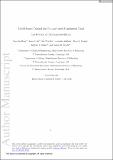| dc.contributor.author | Hong, Moo Sun | |
| dc.contributor.author | Lu, Amos E. | |
| dc.contributor.author | Ou, Rui Wen | |
| dc.contributor.author | Wolfrum, Jacqueline M. | |
| dc.contributor.author | Springs, Stacy L. | |
| dc.contributor.author | Sinskey, Anthony J. | |
| dc.contributor.author | Braatz, Richard D. | |
| dc.date.accessioned | 2022-02-16T18:37:33Z | |
| dc.date.available | 2022-02-16T18:37:33Z | |
| dc.date.issued | 2021-06-07 | |
| dc.identifier.issn | 0006-3592 | |
| dc.identifier.issn | 1097-0290 | |
| dc.identifier.uri | https://hdl.handle.net/1721.1/140434 | |
| dc.description.abstract | Batch low-pH hold is a common processing step to inactivate enveloped viruses for biologics derived from mammalian sources. Increased interest in the transition of biopharmaceutical manufacturing from batch to continuous operation resulted in numerous attempts to adapt batch low-pH hold to continuous processing. However, control challenges with operating this system have not been directly addressed. This article describes a low-cost, column-based continuous viral inactivation system constructed with off-the-shelf components. Model-based, reaction-invariant pH controller is implemented to account for the nonlinearities with Bayesian estimation addressing variations in the operation. The residence time distribution is modeled as a plug flow reactor with axial dispersion in series with a continuously stirred tank reactor, and is periodically estimated during operation through inverse tracer experiments. The estimated residence time distribution quantifies the minimum residence time, which is used to adjust feed flow rates. Controller validation experiments demonstrate that pH and minimum residence time setpoint tracking and disturbance rejection are achieved with fast and accurate response and no instability. Viral inactivation testing demonstrates tight control of logarithmic reduction values over extended operation. This study provides tools for the design and operation of continuous viral inactivation systems in service of increasing productivity, improving product quality, and enhancing patient safety. | en_US |
| dc.language | en | |
| dc.publisher | Wiley | en_US |
| dc.relation.isversionof | http://dx.doi.org/10.1002/bit.27846 | en_US |
| dc.rights | Creative Commons Attribution-Noncommercial-Share Alike | en_US |
| dc.rights.uri | http://creativecommons.org/licenses/by-nc-sa/4.0/ | en_US |
| dc.source | Wiley | en_US |
| dc.title | Model‐based control for column‐based continuous viral inactivation of biopharmaceuticals | en_US |
| dc.type | Article | en_US |
| dc.identifier.citation | Hong, M. S., Lu, A. E., Ou, R. W., Wolfrum, J. M., Springs, S. L., Sinskey, A. J., & Braatz, R. D. (2021). Model-based control for column-based continuous viral inactivation of biopharmaceuticals. Biotechnology Bioengineering. 118, 3215– 3224. | en_US |
| dc.contributor.department | Massachusetts Institute of Technology. Department of Chemical Engineering | |
| dc.contributor.department | Massachusetts Institute of Technology. Department of Biology | |
| dc.contributor.department | Massachusetts Institute of Technology. Center for Biomedical Innovation | |
| dc.relation.journal | Biotechnology and Bioengineering | en_US |
| dc.eprint.version | Author's final manuscript | en_US |
| dc.type.uri | http://purl.org/eprint/type/JournalArticle | en_US |
| eprint.status | http://purl.org/eprint/status/PeerReviewed | en_US |
| dspace.date.submission | 2022-02-09T20:11:28Z | |
| mit.journal.volume | 118 | en_US |
| mit.journal.issue | 8 | en_US |
| mit.license | OPEN_ACCESS_POLICY | |
| mit.metadata.status | Authority Work Needed | en_US |
